Helimax Voltage 500 3D
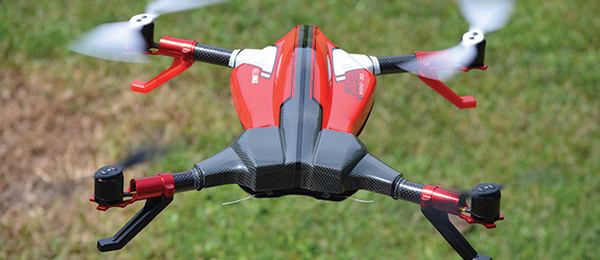
Written by Chris Mulcahy Take your quad experience to the extreme Abridged product review Photos by the author Read the full product review in the May 2016 issue of Model Aviation.
Specifications
Model type: Receiver-ready quadcopter Size: 19.7 inches (500mm) Width: 14.9 inches Blade length: 8.9 inches Weight: 32 ounces without battery Motors: Four 1,400 Kv reversible brushless Needed to complete: Five-channel radio/receiver; three- to four-cell LiPo battery and charger Price: $429.99Pluses
• Orientation-friendly canopy design. • Built-in bailout feature. • Multiple options for flight battery. • Spare propeller set included in the box. • Power—and plenty of it.Minus
• Motor mounts might not handle crashes well.Abridged Product Review
Quadcopters are becoming more popular by the day. Love them or hate them, they are here to stay! I’m sure by now that we are all familiar with camera-toting drones cruising lazily across the sky. What you don’t see in a quadcopter every day is something that can actually challenge your flying skills. Whether you are new to multirotors, or maybe even a helicopter pilot, Helimax might have just the thing to take your flying to the next level. The Voltage 500 is a 3-D quadcopter. Like the few that paved the way before it, the Voltage features reversible motors with symmetrical propellers so you can fly inverted. Unlike the others, the Voltage offers extreme flexibility for flight batteries, an efficient motor/propeller combination for extended flight times, and a unique canopy design that makes orientation a breeze. Did I also mention that as well as having a 3D Mode, its Stability Mode can be used for bailing out of maneuvers?In the Box
The Voltage comes in a large box, hinting at the aircraft’s size. Inside of the box is the fully assembled Voltage 500, an instruction manual, a piece of Velcro (presumably for the flight battery or receiver), and a spare set of propellers. I did not expect there to be an entire set of spare propellers in the box, so I was pleasantly surprised. I also received two 4S FlightPower LiPo batteries for this review—a 2,500 mAh pack and a 3,300 mAh pack. Your own receiver and a flight battery are needed for completion. I chose to use my Futaba 14SG, with an S.Bus-compatible receiver (more on that later).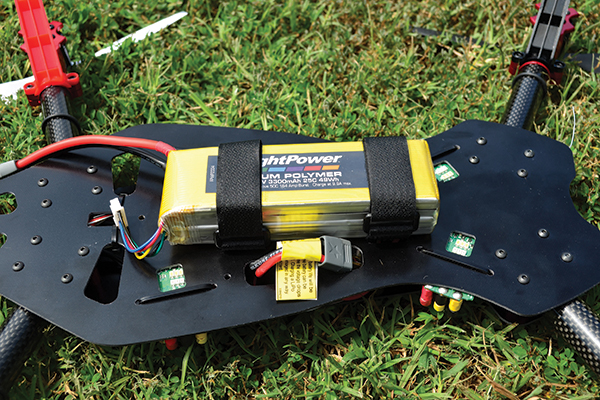
Having the battery strapped beneath the quadcopter allows for a range of possible battery sizes.
The Voltage 500
As you might have guessed from its name, the Voltage 500 is a 500-class quadcopter. If you are wondering what 500 stands for, the multirotor measures 500mm from one motor to the other diagonally across. This 3-D quad is larger than others on the market. The flight controller features a USB port (more on that later), and a receiver output that supports S.Bus, XBus, DSM2, DSMX, DSMJ, and PWM (with an optional S.Bus Encoder). A second plug is used to power your receiver from the flight controller’s built-in BEC. Each ESC has a plug that goes directly into the flight controller, and the motor wires run through the carbon-fiber boom and plug into each ESC. The ESCs have a series of status LEDs on the bottom, which are visible from underneath the airframe. These propellers are big—measuring 8.9 inches from tip to tip. They appear to be unique to the Helimax Voltage because I couldn’t find a match to any other propeller. They come in pairs, an A and a B, both of which are clearly marked with a molded letter on the top of each. If you are unsure of which propeller goes where, the instruction manual has a handy diagram that illustrates the direction.The Flight Controller
The flight controller supports many outputs. I had a spare Futaba R6202SBW, which is an S.Bus-compatible receiver, so I was able to run a single cable from the flight controller to my receiver. For those using satellite receivers on DSM2, DSMX, or DSMJ, there are two satellite ports into which you can plug satellite receivers. There is also a reset button in the middle of the flight controller, just in case it gets confused and locks up (which mine hasn’t done to date).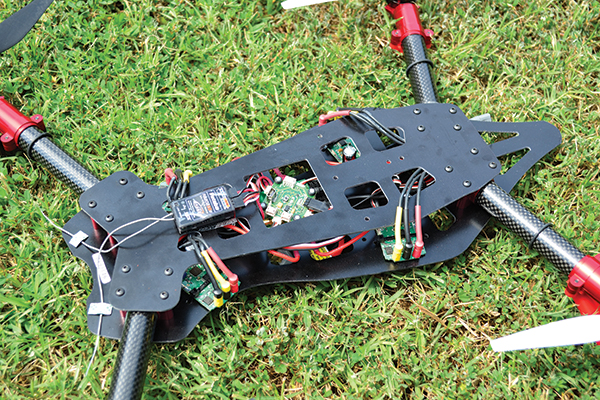
The double-stacked frames allow plenty of room for receiver installation.
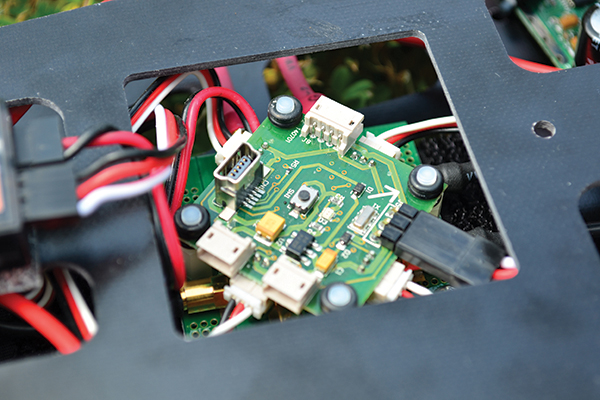
The heart of the Voltage 500 is the flight controller. This is where you attach a USB cable for tuning with a PC.
The App
What is the purpose of that USB port on the flight controller? If you go to the Helimax website, you can download the Voltage 3D app by clicking on the software download tab.The app lets you set your receiver type (a necessity if you are using anything other than S.Bus), and it allows you to verify control functions and directions. It will show you what flight mode you are in, permit you to adjust gain settings, and damper gain on the aileron/elevator and rudder gain. There is a warning about the importance of removing the propellers before you try to adjust any settings. This should be a normal practice anytime you work on a quadcopter when the battery is plugged in.Flying
The controls for the Voltage are much like those on a helicopter. If you divide your throttle stick into two sides, with mid-stick to high-stick being positive and mid-stick to low-stick being negative, you would essentially have a 3-D heli setup. I started with good intentions. I planned to do the whole first flight in Stability Mode, and wait until the second flight before I tried any 3-D maneuvers. Well, that went right out of the window after roughly 20 seconds of hovering. The Voltage is a stable and forgiving machine in Stability Mode, and I believe a novice pilot would have no problem hovering it, but the Voltage was built for 3-D flying. I found myself flipping the switch into 3D Mode almost right away. In 3D Mode, the Voltage becomes a power monster. By that I mean it has monster power! The first full-throttle punch-out that I did surprised the heck out of me because the Voltage shot sky-high at a ridiculous rate of speed. After I got it back down, I tried some flips with it and found it to be responsive, but not overly twitchy. Forward and backward flips, as well as sideways flips, were performed equally well and had a linear feeling in flight. The transition time when reversing the motors was short, and it felt like an old-school collective-pitch helicopter that required the pilot to manage pitch during maneuvers. It didn’t take long to get used to the transition though, and I was able to hold flips without losing any altitude. I wondered how well the bailout feature worked, so I took the Voltage up and popped it into an inverted hover. I flipped my switch into Stability Mode and sure enough, the Voltage flipped itself to a level position. Combining this flight mode with a momentary switch is a great way to practice new maneuvers. The durability of the Voltage is good, but after a few tumbles and crashes, it became evident that the carbon-fiber tubes typically break and the motor mounts have a tendency to bend when they contact the ground. You can bend the motor mounts back with a little force and quickly be up and flying again.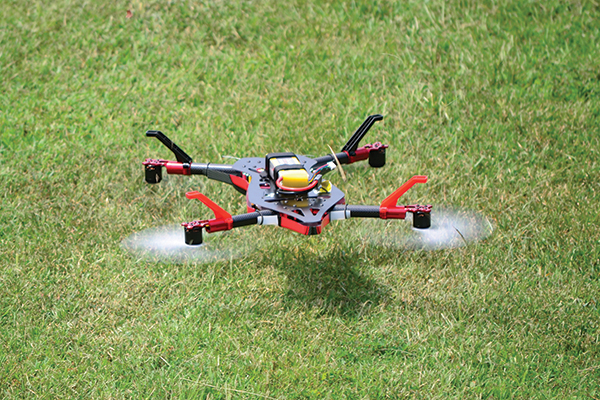










Add new comment